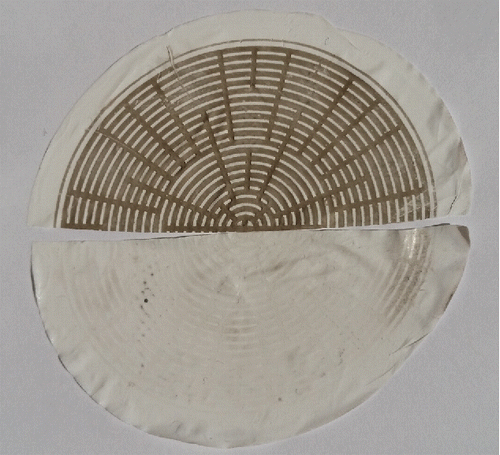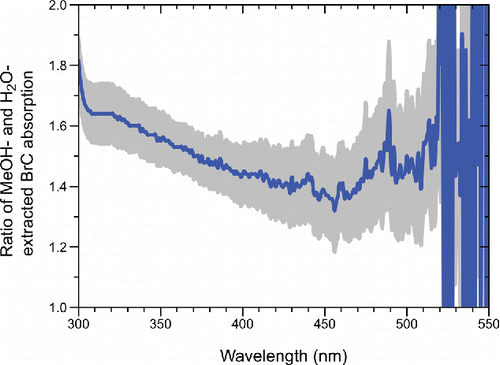Figures & data
Figure 1. Picture of split filter after extraction in water (top) and methanol (bottom). Greater absorption visible on the water half is believed to be associated with insoluble particles remaining on the filter. Note the absence of such absorption on the methanol half. The radial pattern is imposed by the substrate supporting the filter.

Figure 2. Average absorption spectra for methanol-soluble (black line), water-soluble (dark gray [blue] line), and methanol-soluble BrC with particle extinction removed (light gray [red] line). The gray area represents extinction by particles in the methanol extract, while the orange area represents the contribution by BrC absorption.
![Figure 2. Average absorption spectra for methanol-soluble (black line), water-soluble (dark gray [blue] line), and methanol-soluble BrC with particle extinction removed (light gray [red] line). The gray area represents extinction by particles in the methanol extract, while the orange area represents the contribution by BrC absorption.](/cms/asset/65faa0b0-1b66-46ce-ae9f-c4776ba94344/uast_a_1334109_f0002_oc.gif)
Figure 3. Log-transformed plot of absorption spectra for WS and MS extracts. Insoluble particle extinction contributes significantly to apparent MS absorption (black line), but the dual power-law fit (dashed [green] line) accounts for it and the BrC absorption.
![Figure 3. Log-transformed plot of absorption spectra for WS and MS extracts. Insoluble particle extinction contributes significantly to apparent MS absorption (black line), but the dual power-law fit (dashed [green] line) accounts for it and the BrC absorption.](/cms/asset/c33f2739-d5d8-4daa-be20-1728793713ad/uast_a_1334109_f0003_oc.gif)
Figure 4. Comparison of filtration of a sample collected on 8 June 2016 in Athens, GA. (a) Apparent MS absorption spectra either not filtered (black lines), filtered with a 0.45 μm syringe filter (dark gray [blue] lines), or filtered with a 0.22 μm syringe filter (light gray [red] lines). Dashed [green] lines are dual power-law fits and gray/black areas represent suspended particle extinction. (b) Residual MS BrC spectra are similar regardless of extent of filtering. Green dashed lines are single power-law fits. (c) WS absorption spectra with different extents of filtering, as in (a), showing no evidence of particle extinction.
![Figure 4. Comparison of filtration of a sample collected on 8 June 2016 in Athens, GA. (a) Apparent MS absorption spectra either not filtered (black lines), filtered with a 0.45 μm syringe filter (dark gray [blue] lines), or filtered with a 0.22 μm syringe filter (light gray [red] lines). Dashed [green] lines are dual power-law fits and gray/black areas represent suspended particle extinction. (b) Residual MS BrC spectra are similar regardless of extent of filtering. Green dashed lines are single power-law fits. (c) WS absorption spectra with different extents of filtering, as in (a), showing no evidence of particle extinction.](/cms/asset/c29e6e6d-01fd-4931-94c1-e93339476dc2/uast_a_1334109_f0004_oc.gif)
Table 1. Comparison of spectral fits for different extents of particle filtration.
Figure 5. Correlation between integrated absorption (300–800 nm) for WS and MS BrC extracts (dark gray [red] circles). Insoluble particle extinction has been subtracted using a dual power-law function. Linear fits are shown excluding the outlier point (dark gray [red] solid line, point indicated by open dark gray [red] circle) or not (dashed dark gray [red] line). Data without particle extinction subtracted (open squares) and with baseline subtraction (open triangles) and respective fits (black and light gray [green] dashed lines) are also shown for comparison.
![Figure 5. Correlation between integrated absorption (300–800 nm) for WS and MS BrC extracts (dark gray [red] circles). Insoluble particle extinction has been subtracted using a dual power-law function. Linear fits are shown excluding the outlier point (dark gray [red] solid line, point indicated by open dark gray [red] circle) or not (dashed dark gray [red] line). Data without particle extinction subtracted (open squares) and with baseline subtraction (open triangles) and respective fits (black and light gray [green] dashed lines) are also shown for comparison.](/cms/asset/153cfcf7-284c-46de-bb07-e28a91c6178b/uast_a_1334109_f0005_oc.gif)
Figure 6. Correlation between WS and MS BrC absorption Ångström exponents (AAE's) when insoluble particle extinction is subtracted using a dual power-law function (gray [red] points). Values fall close to the 1:1 line indicating correlation between MS and WS AAE values. AAE values for MS spectra fit to a single power-law function (black squares) show more scatter and less correlation with WS AAE values. Measurements from other studies in which AAE's from both WS and MS are shown for comparison (open symbols).
![Figure 6. Correlation between WS and MS BrC absorption Ångström exponents (AAE's) when insoluble particle extinction is subtracted using a dual power-law function (gray [red] points). Values fall close to the 1:1 line indicating correlation between MS and WS AAE values. AAE values for MS spectra fit to a single power-law function (black squares) show more scatter and less correlation with WS AAE values. Measurements from other studies in which AAE's from both WS and MS are shown for comparison (open symbols).](/cms/asset/97daa415-09b3-49b4-8012-ea9014c31f2d/uast_a_1334109_f0006_oc.gif)

